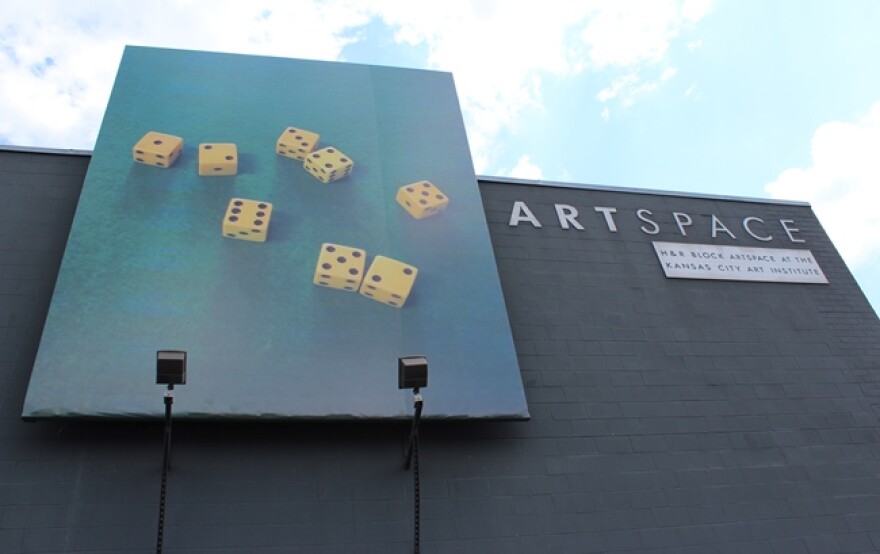The Project Wall, a temporary site for public art at the H&R Block Artspace at the Kansas City Art Institute, currently features Seven by conceptual artist, Luis Camnitzer. This large image of eight ivory dice on casino green felt - spelling out the number seven - is simple yet striking; it draws the attention of those passing by, in cars or on foot, to the exterior of the Artspace, a boxy gray building at the intersection of 43rd and Main Streets.
Raechell Smith, director and curator of the Artspace, invited Camnitzer to carry out this project after his stint as a visiting artist at the Art Institute in April. Smith says she appreciates the artist’s ability to integrate a political message without being too didactic. “For me, Luis’s work helps me create space in my own imagination,” she says.
Born in Germany in 1937 and raised in Uruguay, Luis Camnitzer has lived in New York since 1964. He says he never gave up his Uruguayan contexts, “I see myself as a Latin American witness of things that happen in the U.S.”
An artist, as well as a critic, scholar, curator, and educator, Camnitzer’s known for his use of simple imagery and text. Seven marks his first time showing in Kansas City.
I’ve noticed that you exhibit in Spanish and English. Do you feel that the aesthetic or effect of your artwork changes in either language?
Not the aesthetics but the meaning. Sometimes there are words that you cannot translate or do not have the resonance that they have in one language and things get lost when it goes to the other. In that case I keep it in the original language. There are pieces that only work in English, not in Spanish.
You’re an artist, but you’re also a critic, scholar, curator, author and educator. Why pursue so many professions?
I don’t think I do. I think I am an artist, period, and that I just use any medium available and pick the best medium for whatever problem I am trying to solve. There are issues that are better dealt with in a lecture situation, or in writing, or in communicating verbally with other people. Others can be resolved visually and it changes from problem to problem….[the question] is really, what is my departure point? My departure point is to identify or formulate problems that interest me and to try to solve them as best as I can and to communicate...I am one person with one name and one ability who refers to as many medias as I need.
You’ve stated that all of your works are political "in the sense of wanting to change society." Explain this and how you view your role as an artist.
I think art is not about producing objects but it’s about the effect the objects will achieve. That is a communication and pedagogical function that has therefore, some ethical underpinnings. And the ethical underpinnings that are the crucial ingredients to help improve society, either in a narrow sense of people around me or on a broader sense as in the world...Other people go into medicine or law and hopefully do that not just to make money but to improve society.
In June, the H&R Block Artspace at the Kansas City Art Institute installed your piece Seven on the Project Wall, on the exterior of the building. How did you choose this artwork for this public site?
It’s a recent work, which I liked. It’s still on my mind. It’s about order and disorder and the narrow borderline between chance and order. As you know, those issues interest me. It seemed visually a good piece to be blown up to that size and I thought it might be intriguing to the passerby. One thing that I like is that it won’t stay there forever; I don’t like public art that is always there.
Speaking on public art, your work is typically exhibited in galleries. What is your experience exhibiting in public spaces?
I try to avoid it. I think art in public spaces is intrusive. You have to walk by and look at it. A gallery has the advantage that you can decide not to go up to the gallery….Public art is free, yes, but you cannot avoid it, you have to go around the block and make a decision about walking differently. At the gallery or the museum, you decide you want to go, and you decide if you want to spend money or not, but you don’t have to.
This being your first showing in Kansas City, how do you think the piece Seven introduces people to your work?
I don’t think it’s important, it’s not about me anyway. I think the person, or artist, is totally irrelevant. It’s not designed to introduce people to my work. It’s designed to raise some questions in the minds of the people…I am just the facilitator.
How do you feel Seven interacts with onlookers?
It’s sort of a statistical impossibility in the image that [it] looks random and is not random, therefore, hopefully it raises questions in the mind of whoever looks at it, about how does that happen and about what is random and what is order and who controls it and so on. That’s why I am saying it’s totally irrelevant if Picasso did it or you did it or whoever; it’s really a matter of what questions are being generated by the piece in the viewer’s mind. It’s in that sense that I consider my work political—trying to affect the way people think, or what they think about, and that is not necessarily an issue of political content or party policies; it’s more liberating the minds of people, trying to break down the walls that confine thinking, and that’s a political act.


